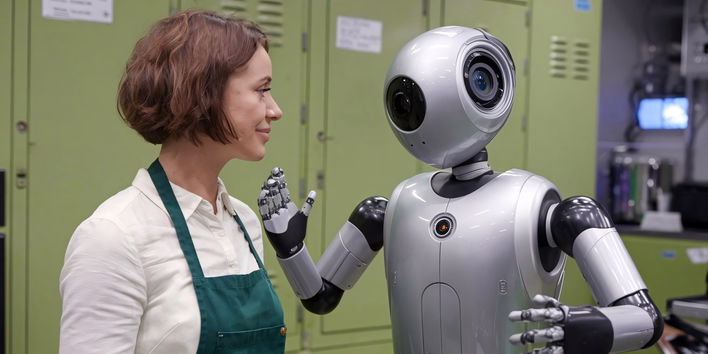- AI
- 11 min read
- March 2025
The Future of Generative AI: What’s Coming Next in 2025?
Generative AI is rapidly transforming industries, and 2025 will be a game-changer. In 2024, the market for generative AI reached $10 billion, with growth projected to skyrocket in the coming years. What does this mean for your business? How can you stay ahead of the curve as Generative AI advances?
Imagine a world where AI systems autonomously create marketing strategies, design interactive virtual experiences, and predict customer needs before they arise. This isn’t science fiction, it’s happening now. Solutions powered by generative AI for content creation, personalization, and design are already reshaping how businesses operate. By 2025, these technologies will be even more powerful, offering businesses new ways to drive innovation and efficiency.
But with these advancements come challenges: How can you adopt generative AI in a way that benefits your business? What opportunities are emerging, and what risks should you be aware of?
This article will explore what’s next for generative AI in 2025, breaking down the trends and innovations you need to know to start leveraging this technology for business growth.
1. Multimodal generative AI: Unifying text, image, video, and code
Generative AI is entering a new era, where models are no longer confined to a single modality. By 2025, AI systems will seamlessly integrate text, images, video, audio, and code, unlocking new possibilities for businesses, content creation, and software development. The future of generative AI will enable more dynamic, efficient, and innovative solutions across industries, reshaping how organizations create and interact with content.
The shift to true multimodal intelligence
Today’s AI models, like GPT-4.5, Gemini 2.5, and Claude 3, can handle multiple formats, but their capabilities are still fragmented. By 2025, next-gen multimodal models will not just process but understand and generate content across multiple data types simultaneously.
Gartner predicts that by 2027, 40% of Generative AI models will be multimodal, up from just 1% in 2023. This rapid transformation signals a move toward AI systems that can seamlessly synthesize and interact across modalities.
i. AI that creates across modalities in a single workflow
Instead of generating text, images, or video separately, next-gen Generative AI will produce cohesive, multimodal outputs in real time.
- Marketing & content: AI will generate fully automated brand campaigns, turning simple ideas into interactive, multimedia experiences.
- Product development: AI-powered prototypes will include written specs, 3D models, and functional code, speeding up innovation cycles.
ii. Text-to-video AI becomes enterprise-ready
AI-powered video generation is rapidly advancing. In 2025, businesses will use AI to create full-scale videos from simple text prompts, removing traditional production barriers.
- OpenAI, Google DeepMind, and Runway will launch more realistic, high-resolution text-to-video models.
- AI will enable personalized, interactive video ads, where content adapts based on user preferences.
- Corporate training, e-learning, and marketing will become AI-driven, reducing production costs and time.
iii. AI that designs & codes interactive products
AI’s role in software development will expand beyond code generation. It will:
- Convert hand-drawn UI sketches into fully functional prototypes.
- Generate interactive product designs that instantly adapt to user feedback.
- Automate app development, allowing non-coders to create functional software using natural language commands.
AI will enable end-to-end product design, from concept to execution, reducing time-to-market significantly.
By 2025, businesses that strategically leverage the future of generative AI will redefine operational efficiency, drive innovation, and gain a sustainable competitive edge, positioning themselves as leaders in an increasingly AI-driven marketplace.
2. The rise of autonomous generative AI agents
Generative AI agents are evolving from passive assistants to autonomous, decision-making systems that can plan, execute, and optimize workflows with minimal human intervention.
In 2025, these generative AI agents will become significantly more advanced, handling multi-step tasks, learning from interactions, and adapting in real time, a shift that will revolutionize business operations.
i. From single prompt to autonomous multi-step execution
AI agents will no longer require constant user input for every task. Instead, they will break down complex objectives into multiple steps, execute them sequentially, and refine results based on feedback.
By 2026, Gartner predicts that 50% of knowledge workers will use AI copilots daily, compared to just 5% in 2023.
ii. Memory-enhanced AI agents with adaptive learning
By 2025, AI systems will retain context over long periods, improving their ability to personalize responses and make informed decisions.
OpenAI, Google DeepMind, and Anthropic are already developing memory-enhanced models that learn user preferences over time, a breakthrough that will enable AI to function more like an autonomous colleague than a simple assistant.
iii. Generative AI agents for business orchestration
Generative AI agents will move beyond individual tasks and orchestrate end-to-end business processes.
With real-time data access and reasoning capabilities, they will automate everything from financial reporting to supply chain optimization, improving operational efficiency by up to 40%, according to McKinsey.
By 2025, autonomous AI agents will redefine work, driving efficiency, cutting costs, and giving businesses a strategic edge in an AI-powered future.
3. Real-time generative AI: Dynamic, data-aware, and contextual
In 2025, Generative AI will move beyond static outputs to real-time, data-aware generation. By integrating RAG and live data, AI will dynamically adapt to new information, delivering more precise and personalized insights.
With enterprise adoption rising, Gartner predicts that by 2026, 60% of AI applications will incorporate real-time data retrieval for enhanced accuracy and relevance.
i. Real-time data integration for smarter AI
Traditional generative AI models rely on pre-trained datasets, making their outputs static and sometimes outdated. In 2025, AI will connect directly to live data sources, including databases, APIs, and web feeds, to generate up-to-date and contextually relevant content.
ii. Dynamic, personalized content generation
In 2025, generative AI will analyze real-time user behavior and external factors to tailor outputs for maximum impact. This will drive:
- eCommerce: Generative AI will generate real-time product descriptions, adjusting copy based on inventory levels, competitor pricing, and customer preferences. McKinsey reports that personalized product recommendations can increase revenue by 10-30%.
- Customer experience: AI chatbots will deliver hyper-personalized responses by accessing live CRM data, enabling more natural and effective customer interactions.
iii. AI that learns and adapts with context awareness
Instead of treating each interaction as independent, next-gen AI models in 2025 will incorporate memory to improve over time. This means:
- AI-powered assistants will remember past interactions and tailor responses based on previous conversations, enhancing continuity and personalization.
- AI-driven reports and dashboards will evolve dynamically, updating key insights as new data becomes available, eliminating the need for manual updates.
The future belongs to those who move with intelligence. Embrace real-time AI in 2025 and lead with speed, precision, and impact.
4. Domain-specific generative models
By 2025, domain-specific generative AI will revolutionize industries like retail, manufacturing, and distribution, enhancing efficiency, personalization, and innovation. Here's how AI will reshape these sectors.
i. Retail: Personalized shopping at scale
Generative AI will help retailers deliver hyper-personalized shopping experiences. AI models will analyze customer behavior, preferences, and purchasing history to generate tailored product recommendations, content, and marketing campaigns.
- AI-driven personalization: In 2025, AI-generated content will create personalized product descriptions, ads, and even promotions tailored to individual shoppers in real-time.
- Enhanced customer journeys: Retailers will deploy dynamic pricing models powered by generative AI, adjusting prices based on demand, competition, and inventory levels.
- Streamlined inventory management: AI will predict demand patterns more accurately, reducing stockouts and overstock situations by up to 20% (Gartner).
By 2025, the global AI-driven retail market is expected to reach $28.5 billion, driven by advancements like AI-powered personalization and predictive inventory management.
ii. Manufacturing: Smarter production and maintenance
Generative AI is set to revolutionize manufacturing by enhancing predictive maintenance, streamlining production lines, and automating design processes.
As the future of generative AI progresses, its impact will be felt across the industry, driving greater efficiency, reducing operational costs, and fostering innovation.
Manufacturers will be empowered to develop smarter, more reliable products while embracing the real-time adaptability essential for success in a rapidly changing market.
- AI-generated prototypes: In 2025, AI will automatically generate 3D models of products, reducing design-to-production times by up to 30% (McKinsey).
- Predictive maintenance: By analyzing sensor data, AI will predict equipment failure, enabling manufacturers to reduce downtime by 25% (Deloitte).
- Supply chain optimization: Generative models will optimize logistics by predicting shifts in supply and demand, reducing costs and improving on-time delivery by 15% (Gartner).
AI-driven manufacturing is projected to increase factory output by 25% by 2025, as automation and real-time insights drive efficiency and cost reduction.
5. Hyper-personalization in consumer experiences
In 2025, generative AI will drive a paradigm shift in how businesses interact with customers. The focus will be on hyper-personalization, where AI tailors every interaction to the individual in real-time, using vast amounts of consumer data and adaptive learning models to continuously enhance and optimize the customer journey.
i. Real-time personalization at scale
By 2025, AI will not only react to customer behavior but predict it. Real-time data from interactions across various touchpoints, websites, apps, social media, and physical stores, will be analyzed instantly, enabling AI to offer contextually aware recommendations and content.
According to a report by McKinsey, businesses that leverage real-time data to drive personalization see up to a 30% increase in customer satisfaction and engagement.
ii. Predictive and anticipatory AI
Generative AI will become capable of understanding context and intent, anticipating customer needs even before they arise.
For example, a retail AI system could predict a customer’s next purchase based on past browsing behavior, social media trends, and seasonality, offering products they are more likely to need.
This predictive capability will dramatically increase conversion rates and create seamless shopping experiences.
iii. Omnichannel Consistency
Hyper-personalization won’t be limited to just one platform. AI will enable businesses to deliver consistent, personalized experiences across all digital and physical touchpoints, be it mobile apps, websites, or in-store.
The AI will adapt messaging, offers, and content dynamically to ensure customers receive a highly relevant and uniform experience no matter where they engage.
iv. Emotionally intelligent AI
By 2025, AI will become emotionally intelligent, capable of interpreting and responding to human emotions in a more intuitive way. Through sentiment analysis and contextual understanding,
AI can personalize interactions based on a consumer’s current mood or state of mind. This will open new doors for empathetic marketing, where brands can connect with customers on a deeper, emotional level.
6. The emergence of smaller generative language models
In 2025, generative AI will shift toward smaller language models (SLMs) that bring the power of AI-driven content creation to more accessible platforms and industries. As the generative AI market continues to grow, these smaller models will play a crucial role in shaping how AI is deployed in real-time applications, offering flexibility, cost-effectiveness, and speed.
i. Reduced complexity, increased accessibility
While today’s large language models (LLMs) require significant resources to train and deploy, generative AI models in 2025 will increasingly be powered by smaller, specialized models.
These models will offer AI-generated content with fewer computational demands, making them ideal for integration into everyday devices like smartphones, IoT devices, and smart applications.
ii. Faster, more focused training
Generative AI will use smaller datasets tailored to specific use cases, reducing the time and cost typically required for training LLMs.
These SLMs will allow businesses to deploy customized AI-generated outputs rapidly, offering a quicker path to production and better alignment with niche market needs.
iii. Affordable, scalable AI content creation
As generative AI becomes more widespread, the emergence of smaller models will lower the barrier to entry for companies looking to implement AI in personalized content generation, whether for customer service chatbots, marketing automation, or product descriptions. Smaller models will enable scalable AI systems without compromising on performance or quality.
iv. Real-time adaptation and local deployment
With generative AI increasingly capable of being deployed locally on devices, real-time content generation, driven by smaller, more efficient models—will become a significant shift in consumer-facing applications. Users can expect context-aware, real-time AI-generated responses that are both cost-effective and powerful.
The future of generative AI will enable smaller, more efficient models to drive scalable, personalized content creation while optimizing costs and resources.
7. Generative AI for synthetic data and simulation
As we approach 2025, Generative AI will become a cornerstone of innovation in fields like healthcare, autonomous driving, finance, and beyond. Here’s a closer look at how this technology will evolve, focusing specifically on synthetic data generation and simulation.
i. Synthetic data generation
By 2025, the synthetic data market is expected to grow by over 40% CAGR, driven by generative AI's ability to produce realistic data for training AI models.
Industries struggling with data privacy regulations, such as healthcare and finance, will leverage synthetic data to build robust models without violating privacy laws.
ii. Consumer behavior and market simulation
Generative AI will enable businesses to simulate complex consumer behaviors and predict market trends with unprecedented accuracy. In fact, Gartner forecasts that 75% of enterprises will use AI-driven simulations by 2025 for strategic planning and product testing.
This will allow businesses to assess consumer reactions to new products or marketing campaigns before launching in the market, minimizing risk and optimizing results.
iii. Digital twins
Digital twins, powered by generative AI, are expected to see exponential growth. The global digital twin market is projected to reach $84 billion by 2025, with generative AI playing a critical role in creating realistic simulations of physical systems.
These models will enable businesses to predict failures, optimize processes, and improve performance without physically testing every scenario.
iv. Advancing R&D
By 2025, generative AI will revolutionize R&D across industries by leveraging synthetic data and simulation. AI will enable businesses to generate highly accurate synthetic datasets, reducing the need for expensive, time-consuming real-world testing.
Through simulation, AI will model complex scenarios, accelerating product development, enhancing design processes, and reducing errors. This shift will allow companies to innovate faster, optimize their R&D strategies, and significantly shorten the time-to-market.
v. Compliance testing
In 2025, generative AI will be key in helping companies meet stricter regulatory standards by simulating various compliance scenarios. This will allow organizations to test AI models and data usage protocols in controlled, synthetic environments.
Regulatory frameworks like the EU AI Act and U.S. draft legislation will drive the need for such simulations, ensuring that businesses can meet compliance standards before launching AI-powered products.
Preparing for the future of generative AI
Generative AI is poised to transform industries by 2025, from enhancing customer experiences to improving decision-making and operational efficiency. But how can your business start benefiting from these innovations today?
The key to staying ahead lies in understanding how generative AI can seamlessly integrate into your business model and unlock new opportunities. Taking small, manageable steps now will position your company to fully capitalize on AI’s transformative power when the time comes.
At Rapidops, we help businesses like yours navigate the world of generative AI with a tailored approach. Whether you're exploring AI for the first time or looking to enhance current strategies, our experts will guide you in identifying the most impactful AI applications for your specific needs.
Ready to unlock the potential of generative AI?
Take the next step with us. Schedule a consultation call with one of our AI experts, and together we’ll explore actionable next steps to help your business thrive in the AI-driven future.
What’s Inside
- 1. Multimodal generative AI: Unifying text, image, video, and code
- 2. The rise of autonomous generative AI agents
- 3. Real-time generative AI: Dynamic, data-aware, and contextual
- 4. Domain-specific generative models
- 5. Hyper-personalization in consumer experiences
- 6. The emergence of smaller generative language models
- 7. Generative AI for synthetic data and simulation
- Preparing for the future of generative AI




